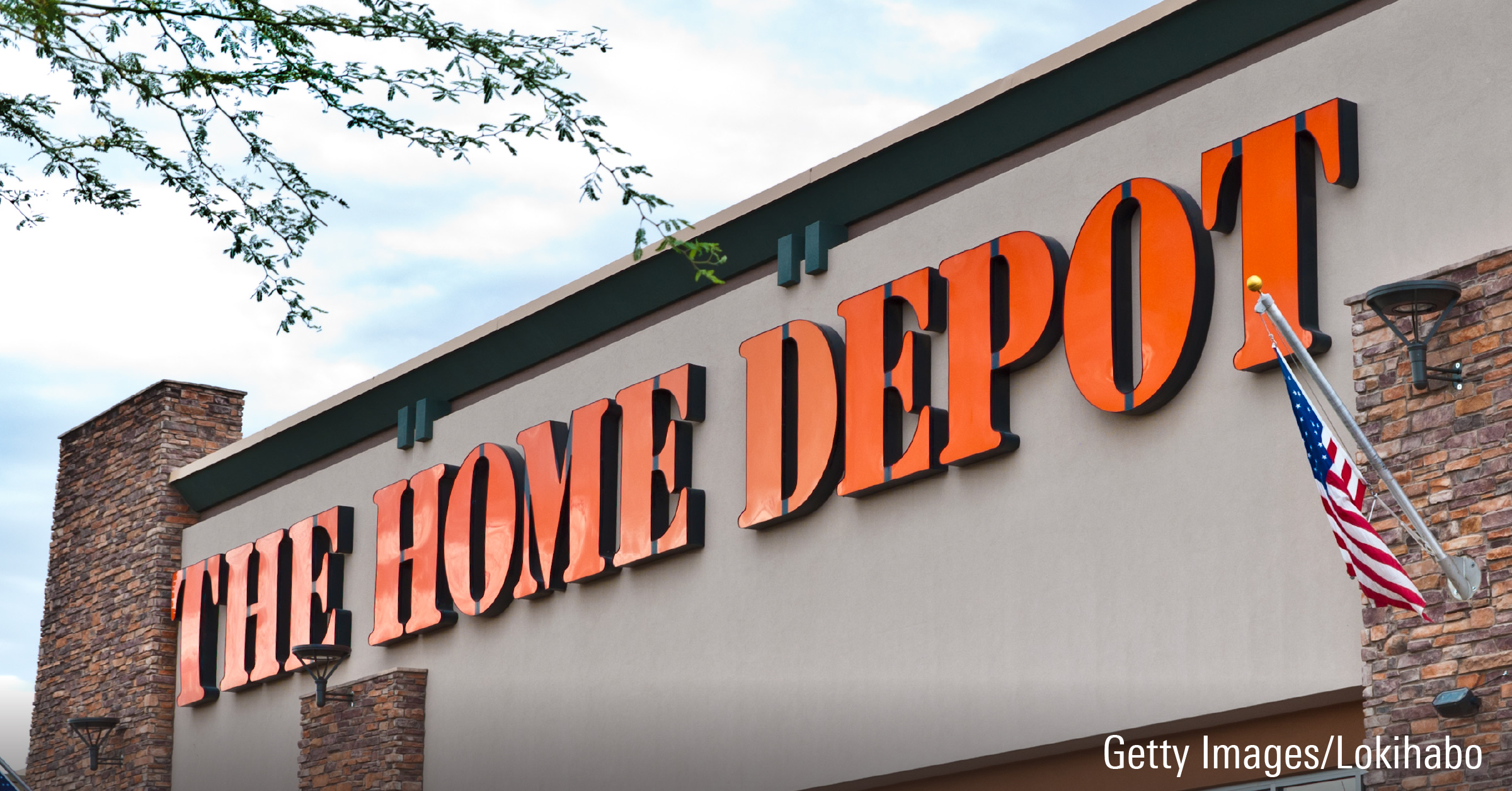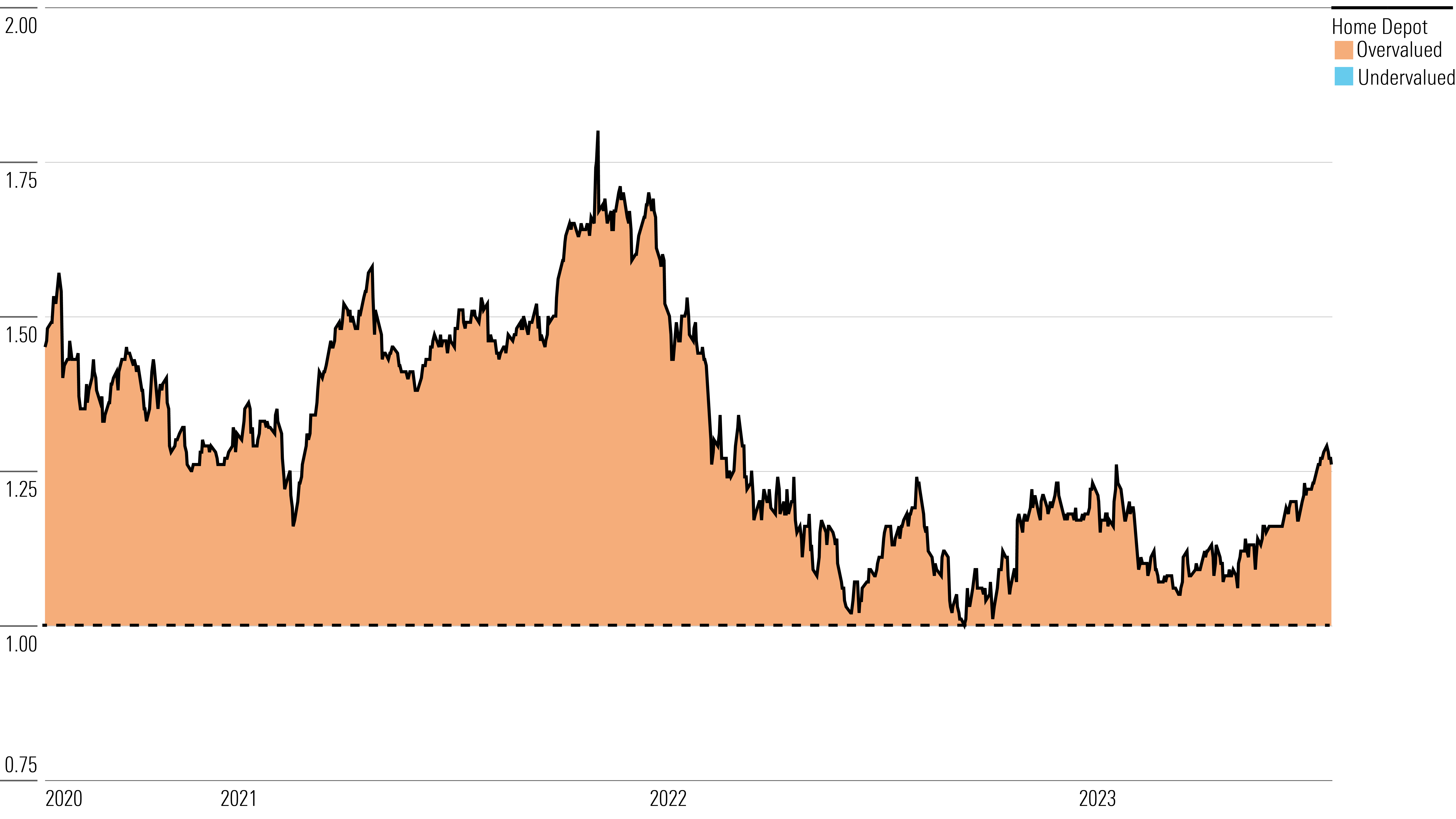Ahead of Earnings, Is Home Depot Stock a Buy, a Sell, or Fairly Valued?
We’ll be watching the pro backlog and whether consumers are pulling back on spending.

Home Depot HD is set to release its second-quarter quarter earnings report on Aug. 15 before the market open. Here’s Morningstar’s take on what to look for in Home Depot’s earnings and stock.
Key Morningstar Metrics for Home Depot
- Fair Value Estimate: $259.00
- Morningstar Rating: 2 stars
- Morningstar Economic Moat Rating: Wide
- Morningstar Uncertainty Rating: Medium
What to Watch in Home Depot’s Earnings
- We’re keeping an eye on the extent to which Home Depot’s top line was affected by softer discretionary spending (through transaction count and comparable average ticket) and unseasonal weather, which negatively impacted its peer Tractor Supply’s recent earnings results. We’ll also be watching for signs of trade downs in management commentary during their earnings call.
- We’re also interested in hearing about the pro backlog (to gauge demand) and whether pro growth continued to underperform do-it-yourself in the second quarter.
- We’re curious about any update to the company’s recently announced plan to grow complex pros (largely renovators that represent a $200 billion market, where Home Depot remains underpenetrated).
Home Depot Stock Price
Fair Value Estimate for Home Depot Stock
With its 2-star rating, we believe Home Depot’s stock is overvalued compared with our long-term fair value estimate.
We lowered our fair value estimate to $259 per share from $267 to account for slowing top-line momentum and resulting sales deleverage. Nonetheless, Home Depot continues to invest in merchandising, supply chain, and employees, which we contend should support its brand intangible asset. For 2023, we now expect $153 billion in sales, a 14.3% operating margin, and $15.23 in earnings per share.
Given the maturity of the domestic home improvement industry, we expect demand to largely depend on changes in the real estate market, driven by prices, interest rates, turnover, and lending standards. We project 2% average sales growth over the next five years, supported by 2% average same-store sales increases, better merchandising, and offerings like buying online with in-store pickup.
In the longer term, we forecast gross margins to expand modestly over the next decade (by 10 basis points from 2022 levels, to 33.6%) while the selling, general, and administrative expense ratio remains flattish (around 17%) as Home Depot capitalizes on its scale and supply chain improvement initiatives while also investing to protect its market leadership perspective. This leads to a terminal operating margin of 15.5%, higher than the 15.3% peak achieved in 2022.
Read more about Home Depot’s fair value estimate.
Home Depot Historical Price/Fair Value Ratio

Economic Moat Rating
We assign Home Depot a wide economic moat. Since it’s the largest global home improvement retailer, we believe it possesses a competitive edge based on its brand intangible asset and cost advantage.
Over the past 10 years, Home Depot’s sales growth has outpaced the 6.2% average growth in the building materials, garden equipment, and supplies dealer industry by 160 basis points annually (based on U.S. Census Bureau data), an indication of the brand’s ongoing relevance. We surmise the company’s strong brand equity and extensive scale should enable incremental market share gains in the highly fragmented $1 trillion North American home improvement market, on top of the high-teens market share it has amassed thus far (given roughly $157 billion in sales in 2022).
Dissecting the components of Home Depot’s competitive prowess, we think its impressive same-store sales growth, which has averaged 7% over the past 10 years, suggests it has a brand intangible asset. We believe its extensive product offerings and services have fostered brand loyalty. The firm moves 30,000-40,000 stock-keeping units in-store and 1 million units online, allowing consumers to save time and effort by visiting one shop for all a project’s needs. To continue to engage its consumers and keep up with changing demand (for localization and personalization, for instance), Home Depot leverages consumer data, collaborates with its suppliers, and conducts periodic merchandising resets to better refine its assortments.
Apart from its trusted national brands, Home Depot holds eight private-label brands that primarily cater to DIY customers, who tend to be brand-agnostic. We think those brands not only allow for broader product selection and brand positioning but also provide margin benefits. (While such figures are not disclosed, we estimate private-label gross margins to be a few hundred basis points above national brands.) Additionally, Home Depot’s value-added services (including tools and trucks rental, installation, and remodeling) allow for the smooth undertaking of projects, which in our view further elevates the customer experience.
Read more about Home Depot’s moat rating.
Risk and Uncertainty
We give Home Depot a Medium Uncertainty Rating, owing to its strong brand recognition, which has helped stabilize sales through the cycle. Sales are largely driven by greater consumer willingness to spend on category goods, with stable existing-home price growth and decent turnover. Thanks to the maintenance, repair, and operations (MRO) business (Interline Brands and HD Supply), pro revenue could be less cyclical, as the maintenance side of the business can prove more consistent.
In uncertain economic times, consumers remain in their homes, embarking on improvement projects and boosting do-it-yourself revenue. Alternatively, when home prices rise, the wealth effect generates a psychological boost to consumers, reinvigorating professional sales thanks to a higher willingness to spend on big projects. A diverse consumer base helps normalize revenue even in uneven times. Currently, about half of sales are in the do-it-yourself arena, while the rest is generated from pro customers.
Although new competitors could set up shop on Home Depot’s turf, we think they would be hard-pressed to offer similar product prices, as they likely wouldn’t have vendor relationships of the same magnitude. Ultimately, the biggest brands in home retailing will still want the biggest partners for distribution, leaving a new peer in a precarious position when acquiring enough of the most sought-out products to satisfy demand.
Read more about Home Depot’s risk and uncertainty.
HD Bulls Say
- Home Depot’s continued investments in supply chain and merchandising should improve productivity and support its market leadership position in the home improvement market.
- The company has returned $70 billion to shareholders through dividends and share buybacks over the past five years, above 20% of its market cap. We forecast Home Depot returning another $80 billion to shareholders over the next five years.
- The addressable MRO market is around $100 billion, and Interline and HD Supply make up a low-double-digit share, leaving meaningful upside available.
HD Bears Say
- Weak consumer spending, higher interest rates, or an economic downturn could hinder sales for home improvement projects and affect Home Depot’s growth.
- IT and supply chain improvement gains could prove more challenging to achieve, as simpler efforts have already borne fruit. Further productivity efforts could face some implementation risks, creating inconsistent profitability.
- As the home improvement demand normalizes, consumers could continue to shift discretionary spending away from home improvement and back into other discretionary categories like leisure and restaurants.
This article was compiled by Tom Lauricella
The author or authors do not own shares in any securities mentioned in this article. Find out about Morningstar’s editorial policies.


/cloudfront-us-east-1.images.arcpublishing.com/morningstar/5GAX4GUZGFDARNXQRA7HR2YET4.jpg)
/cloudfront-us-east-1.images.arcpublishing.com/morningstar/U746MWXQHFFZPLSMTEJSUD7HLY.png)
/cloudfront-us-east-1.images.arcpublishing.com/morningstar/KPHQX3TJC5FC7OEC653JZXLIVY.jpg)